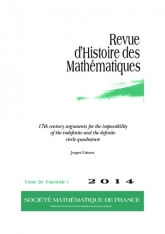Arguments du xviie siècle en faveur de l'impossibilité des quadratures du cercle indéfinie et définie
17th century arguments for the impossibility of the indefinite and the definite circle quadrature

- Consulter un extrait
- Année : 2014
- Fascicule : 2
- Tome : 20
- Format : Électronique
- Langue de l'ouvrage :
Anglais - Class. Math. : 01A45, 12-03, 51M04, 51M15
- Pages : 211-251
- DOI : 10.24033/rhm.182
Le problème ique de la quadrature (ou de la rectification) du cercle a connu un regain d'intérêt pendant la deuxième moitié du xviie siècle. Les nouvelles méthodes analytiques ont permis la découverte d'expressions infinies du nombre $\pi $ et ont ouvert la voie vers les premières tentatives de démonstration d'assertions d'impossibilité concernant la quadrature du cercle. Dans cet article les arguments d'impossibilité de Wallis, Gregory, Leibniz et Newton sont analysés et les controverses qu'ils ont causées sont discutées. Tous les arguments concernent l'impossibilité de trouver une expression algébrique de l'aire d'un secteur d'un cercle en termes de son rayon et de sa corde ou de l'aire du cercle entier. Les controverses sont en partie dues à l'imprécision de la formulation des résultats. Les résultats d'impossibilité sont tous issus d'une entreprise mathématique constructive. Leur but était de démontrer qu'une certaine solution de la quadrature du cercle est la meilleure possible parce que des solutions plus simples (analytiques) sont impossibles.
xviie siècle, histoire des mathématiques, quadrature du cercle, pi, impossibilité, fonctions transcendentales, Wallis, Gregory, Leibniz, Newton.

